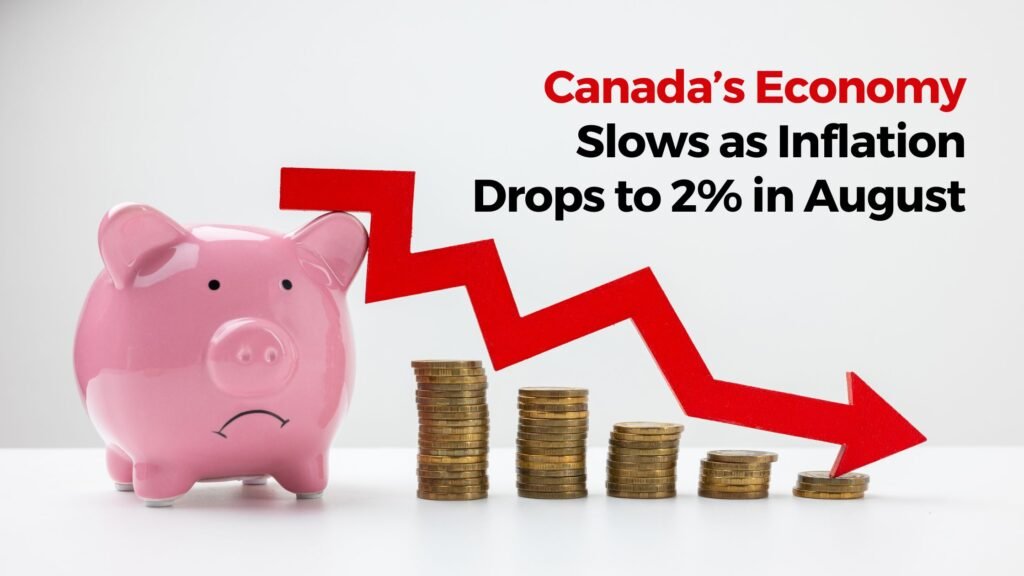Canada’s economy progressed remarkably in August 2024 as its inflation rate went to 2%. This is a good sign of prices becoming more or less standard. However, the gradual pace of economic growth raises doubts concerning the country’s prospects
However,for Canadians, a reduction in inflation means a sigh of relief from the rising costs of important commodities and services. Unfortunately, a weakening economy also poses other problems especially for businesses and those seeking jobs.
In this article we will get to know about the possible challenges and benefits brought by maintaining the inflation rate at 2%, what triggered the recession, who’s to bear the recession, and the future of the economy of Canada.
The Fall of Inflation: Self Destruction
Deflation, on the other hand, would mean a decrease in prices which results in the increased purchasing power. In the past two, or more, years Canada, just like the rest of the world, has been experiencing unfortunate high inflation caused by various factors such as supply chain problems, global energy prices hike, and more so tantalizing the world in the post-pandemic phase. The number tends to be around the 2 percent mark, an inflation level that is seen as an ideal target for most of the central banks such as the Bank of Canada. It allows for reasonable equilibrium and assurance for all involved in the economy.
Contributors to the Economic Slowdown
It should be noted that the fall in inflation is not occurring in isolation. Some reasons that have led to the further deterioration in the economic performance of Canada.
- Interest Rate Hikes: In order to bring down inflation, the Bank of Canada has been hiking interest rates sharply. While achieving success in containing the inflationary tendency, the policy has yet had the detrimental outcome of increasing the cost of capital. Change in expenditure interest rates causes taking long-term loans for purchasing things, and doing investments to fall and ultimately economic growth as well slows down. For example, the housing sector has cooled as mortgage rates rise, and many Canadians are delaying on making big-ticket items or expansion of businesses.
- Global Economic Conditions: The economic performance of Canada is much swayed by the performance of other economies across the globe. Such countries especially U.S. and some in Europe are also experiencing recession which results in less demand for Canadian exports. The international trade and foreign investment practices have also been stagnant with reasons such as disruption of global supply chain, after effects of the pandemic as well as geopolitical differences such as the Ukraine war.
- Stagnating Wage Increases: Even though the general employment environment in Canada has not changed drastically, the increase in wages over the years has failed to keep up with the rate of inflation. Even with an inflation of 2%, most if not all Canadians continue to be tight since their earnings do not grow sufficiently to cover basic living expenses.
- Effects on Other Industries:The 2% inflation and slow economic growth have a mixed impact on different sectors. For some sectors, it is boom time, while for others, things are really bad.
- Retail: Retailers are suffering from the negative effects of less consumer expenditures. Although still declining, inflation’s reduction of certain prices does not take away the fact that consumer spending remains prudent since no one knows when recessionary conditions will recur again. In order to entice consumers to spend more, retailers have been forced to rely on more lavish discounting and promotions-most disadvantageously for their bottom lines.
- Energy Sector: Energy in Canada, including oil and gas production, is one of the country’s most vital sectors of the economy. While worldwide energy prices have had many ups and downs during the last few decades, diminishing demand elsewhere in the world has been very negative in this area. The lower inflation as well as slower economic growth reduce the revenues of the energy companies and then their investments in new projects.
- Manufacturing and Trade: Its manufacturing industry, largely export-dependent, is also being affected. Overall global economic conditions and relatively softer demands from its business partners have led to lower manufacturing output. Automotive, machinery, and chemicals have been the worst hit so far. With the slowdown of its important neighbor, the U.S., Canadian manufacturers have now been confronted with softening demand for their products, leading to cuts in production and redundancies in some areas.
Bright Sides of the 2% Inflation Rate
Economic slowdown brings about some positives with the introduction of a 2% inflation rate.
Stable Prices: In the eyes of the consumer, this translates into stable prices no longer rising at the speeds observed a few years back. The prices of basic needs from food and shelter to transport have stabilized, meaning that families and households have more predictability in their family budgets each month.
Lower Interest Rates: The continuing stabilization of inflation likely reduces the interest rate at the Bank of Canada. A decrease in interest rates lowers the costs of borrowing on the balance sheet on both sides-consumers as well as businesses –resulting in a stimulation of spending and investing, respectively. This should lead to higher growth rates going forward, especially if sectors like real estate and retail will have to do more business than they are already doing.
Stronger Currency: If the inflation rate is kept stable, then this would most of the times result in a stronger national currency. The Canadian dollar will strengthen once more due to the controlled inflation, making imports cheaper and strengthening the purchasing powers of Canada in the world market. This will come as another respite for the consumers because costs associated with imported commodities dwindle.
Government Initiatives and Economic Prospects
The Canadian government and the Bank of Canada are tracking this closely. With inflation at 2%, policymakers will then have to moderate growth to protect price stability and potentially prevent interest rate hikes hereafter, but reversal of rates would again strengthen inflationary forces.
The government can also use policies such as infrastructure spending as well as support the struggling industries. Further increases in consumer confidence and spending will be brought about by policies that improve wage growth.
Summing Up
Hope this article helps you in understanding that a reduction in inflation means a sigh of relief from the rising costs of important commodities and services. Unfortunately, a weakening economy also poses other problems especially for businesses and those seeking jobs.
To get more latest information follow our newsletter.








Leave a Reply